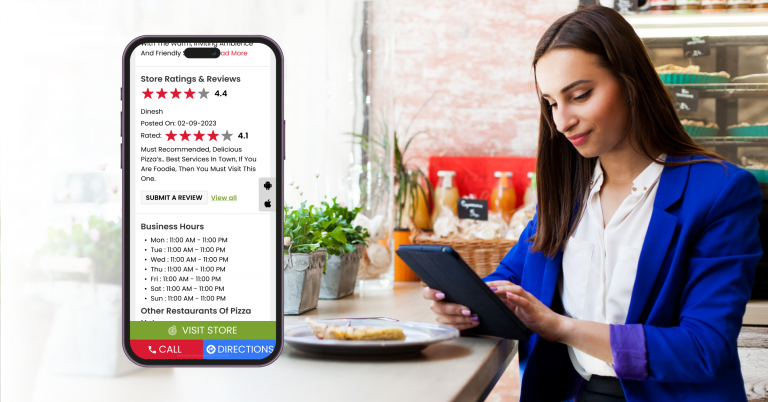Today, in this evolving digital world, online platforms play a pivotal role. Surveys reveal that 76% (source: Think with Google)of consumers who search nearby businesses on their mobile phones visit the store within 24 hours, and 28% of these searches end up in a purchase.
As consumers increasingly turn to online platforms for the convenience of exploring, evaluating, and ultimately purchasing products, the importance of a strong online presence cannot be overstated. To capitalize on this trend and bridge the gap between virtual and physical business locations, businesses should prioritize implementing tools such as well-designed store locators.
A well-crafted store locator enhances the local search directories and helps consumers by making it easier for potential buyers to find and visit your business location. As a store owner, you must create an intuitive, user-friendly interface that guides consumers to your doorstep.
This guide will delve into how an effective store locator can increase foot traffic to your store, exploring it as an indispensable tool in driving in-store visits and enhancing the overall consumer journey.
A store locator is critical for businesses, especially in the retail sector. It’s essentially a digital capability that allows consumers to easily find store locations based on their address or current location. This feature is particularly useful for businesses with multiple outlets, as it helps consumers locate the nearest store with the products or services they need. In today’s fast-paced ecosystem, these bring greater convenience to consumers, enabling brands and their business locations to form stronger associations.
Store locators are commonly integrated into websites through various technical methods. Brands often use APIs (Application Programming Interfaces) provided by mapping platforms such as Google Maps to embed interactive store locator features.
To add a single-store location map to your website easily, use the Embed API’s quick start guide. It generates code for you to paste into your site, allowing visitors to interact with the map and get directions. You’ll need an API Key for this method.
For a more comprehensive store locator with multiple locations and directions, you can use a JavaScript plugin for a quick solution or follow our store locator code lab to build a custom locator using your JavaScript skills.
Businesses can customize the parameters and settings within the API to make store locators more flexible. This may include options to showcase different store attributes, filter results based on user preferences, or integrate additional features like real-time inventory updates.

Think about the journey from a digital map pin to your store’s front door. A well-crafted store locator is all about convenience—a crucial bridge connecting online curiosity to in-store foot traffic.
But what makes a store locator draw consumers from their screens to your shop’s aisles?
Store owners must smartly leverage business listing platforms, local citations, and local search directories to enhance visibility and ensure it reaches a wider audience. Here’s how it can further help a store:
By enriching a business’s online content, a store locator improves its likelihood of appearing in local online searches, particularly on popular search engines such as Google, making the business more accessible to consumers.
With its intuitive product portfolios, partners such as SingleInterface can help you maximize your store locator’s effectiveness, ensuring your business stands out and attracts more consumers.
Local search directories are key to directing potential consumers to your physical locations. A store locator that provides easy access to store locations, hours, and other vital information via these directories enhances user convenience. This ease of access and discoverability encourages consumers to pay visits to stores, increasing potential revenue opportunities.
Local citations, which include essential business details like name, address, and phone number, are also crucial for local search engine ranking. A store locator effectively managing these citations across various platforms can significantly improve a business’s visibility in local search results. Better visibility in local searches translates to more in-store visits, as consumers can easily find and choose your business over competitors.
Regular visits to your website contribute to increased customer engagement and the likelihood of them visiting your physical store. You can incorporate “sticky” elements strategically designed to retain customers and bring them back to the website. Installing a store locator is one of the sticky elements. It provides valuable business information not found on platforms like Google Maps but also adds significant value, leading to more site visits and boosting sales.
Optimizing your website with a store locator reduces the volume of routine calls your business receives regarding basic information such as address or product availability. By making this information easily accessible online, particularly through the store locator, your in-store staff can deliver exceptional service to existing and potential customers.
A store locator offers digital convenience by providing 24/7 access to information about local store inventory. This feature allows consumers to check product availability at their nearest stores before they visit. Such accessibility saves consumers time and effort. In turn, it builds trust between the consumer and the business. It also strengthens the business’s overall branding, as consumers appreciate the ease and reliability of accessing information through the store locator.
The role of a well-designed store locator in driving foot traffic to physical stores cannot be overstated. By leveraging business listing platforms and top business directories, a store locator can bridge the gap between website check-ins and physical consumer visits. It’s not just about guiding consumers to your doorstep; it’s about enhancing your visibility in the digital landscape, ensuring your business stands out in local searches, and providing potential consumers with the information they need at their fingertips.
Do you want to increase in-store visits? SingleInterface can help you enhance your overall business presence and drive more foot traffic.